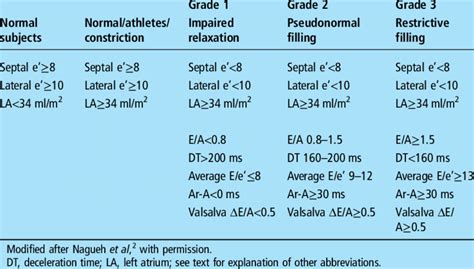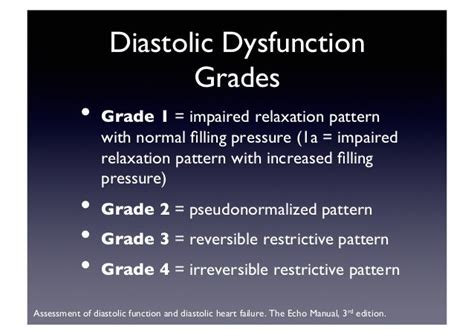lvdd grade 1 Grade I: Slightly impaired diastole; Grade II: Elevated pressure in the left side of the heart; Grade III: Very elevated pressure in the left side of the heart; Grade IV: Advanced heart failure and very elevated pressure on the left . 100% ëlektriskais Citroën ë-C4 nodrošina klusu un ērtu elektrisko braukšanu. Tas ir aprīkots ar 50 kWh jaudas akumulatoru, kas nodrošina līdz 357 km autonomiju (WLTP ciklā). Akumulators garantē 8 gadu vai 160 000 km ilgtspēju, nodrošinot 70% no tā uzlādes jaudas. Tas ļauj arī ietaupīt naudu:
0 · ventricular diastolic dysfunction grade 1
1 · lv diastolic dysfunction grade 1
2 · left ventricular relaxation grade 1
3 · grade 1 diastolic relaxation abnormality
4 · grade 1 dd in echo
5 · echocardiogram grade 1 diastolic dysfunction
6 · doppler evidence of grade 1
7 · diastolic dysfunction grading chart
LVT should be considered a marker of increased long-term thrombotic risk that may persist even after thrombus resolution. Ongoing clinical trials are expected to elucidate the best management strategies for patients with LVT.
Grade I is slightly impaired diastole. It is a common finding in people over age 60. Grade II is elevated pressure in the left side of your heart. Grade III is significantly elevated pressure in .

rolex 16013
A normal filling pattern in community-dwelling subjects indicates an excellent prognosis. 1 In contrast, an abnormal filling pattern and progressively greater abnormalities of . Diastolic dysfunction occurs when the heart has a hard time relaxing between each beat. This causes restricted blood pumping and increased pressure, which leads to diastolic heart failure (also known as heart failure . Grade I: Slightly impaired diastole; Grade II: Elevated pressure in the left side of the heart; Grade III: Very elevated pressure in the left side of the heart; Grade IV: Advanced heart failure and very elevated pressure on the left .

ventricular diastolic dysfunction grade 1
What Is Diastolic Heart Failure? Medically Reviewed by James Beckerman, MD, FACC on May 16, 2023. Written by Mary Jo DiLonardo. What Causes It? Symptoms. . When your heart isn’t able to relax fast enough, it’s called diastolic dysfunction (DD). DD is dangerous and is believed to be associated with congestive heart failure symptoms in patients who have what’s called .
In patients with reduced LV ejection fraction, E/A ratio ≤0.8, and a peak E velocity ≤50 cm/s, there is normal LAP, representing grade I of DD. If E/A ratio is >2, this represents elevated filling pressures and LVDD is classified as . Diastolic heart failure, also known as heart failure with preserved ejection fraction (HFpEF), is a condition in which your heart’s main pumping chamber (left ventricle) becomes . Left ventricular diastolic dysfunction (LVDD) occurs in many different patterns – from simple slowing of ventricular relaxation, without significant hemodynamic consequences . Grade 1 Diastolic Dysfunction and Treatments. Treatment . Treating diastolic dysfunction is really about treating the underlying causes. Losing weight, exercising, managing blood pressure, keeping diabetes under .
lv diastolic dysfunction grade 1
left ventricular relaxation grade 1
In rececent general health checup , Echo report says Grade 1 diastolic dysfunction , although other comments are : all chamber dimension normal , No RWMA , Normal LV systollic function , Grade 1 diastolic dysfunction , Trivial MR & TR / No PAH , No e/o clot (or) vegetation .

May 1, 2020 / Health Conditions / Heart Health. Why Diastolic Dysfunction Raises Death Risk. . If you show symptoms of DD, your doctor will grade it as mild, moderate or severe.
MACE during the 1-year follow-up period was obtained from medical records. Kaplan-Meier and Cox's regression analyses were used to investigate the relationship between LVDD grades and MACE. Results: Postdialysis orthostatic hypotension and PS, but not CIMT, ABI, or baPWV, increased proportionally with LVDD grades. Eleven patients developed MACE .
35 yrs old Female asked about Lvdd grade 1, 1 doctor answered this and 1823 people found it useful. Get your query answered 24*7 only on | Practo Consult Grade 1 patients also differed from grade 2 (p = 0.02), but no differences were seen in the other between-group comparisons. The positive predictive value of DD of any grade for detecting Tau > 48 ms was 49.0%. Similar results were seen when patients with low septal or lateral e’ but left atrial volume index <34 mL/m 2 were excluded (p = 0. . Most of the LVDD patients were at Grade 1/mild severity. Older age, insulin therapy, and Chinese ethnicity were risk factors for diastolic dysfunction. Such findings emphasize the need for regular screening and monitoring for progression of cardiac dysfunction as well as appropriate therapeutic risk mitigation measures given the long-term . For example, grade 1 LVDD occurred in 31.7% of Child B class, 31.4% of Child C and only in 17.5% of Child A class. Control groups of healthy subjects were formed in 9 studies[15,24-26,31,35-38]. It is interesting to note that in Cesari et al and in Hammami et al research some controls had LVDD. Hammami .
As we now know, CAN is associated with LV diastolic dysfunction (LVDD), both in patients with long-term type 2 or type 1 diabetes. LVDD may progress to heart failure, mainly with preserved LV systolic function (diastolic heart failure), which is also related to high morbidity and mortality rates. Sudden, unexpected deaths occur among subjects . Of the patients with mild-to-moderate LVDD (Grade I and II) with preserved left ventricular ejection fraction (EF), 225 with LVH (LVH group) and 225 without LVH (non-LVH group) were consecutively selected. LVDD was defined by the abnormal patterns of Doppler mitral inflow and tissue Doppler. Left ventricular filling pressure (FP) was estimated .
Dysfunction Grade 281 IV. Conclusions on Diastolic Function in the Clinical Report 288 V. Estimation of LV Filling Pressures in Specific Cardiovascular Diseases 288 A. Hypertrophic Cardiomyopathy 289 B. Restrictive Cardiomyopathy 289 C. Valvular Heart Disease 290 D. Heart Transplantation 292 It is generally accepted that mild impairments of left ventricular diastolic function manifest as delayed early relaxation. The adequacy of the initial phase of diastole is reflected by Tau, the time constant of ventricular pressure decay [1, 2].The pattern of echocardiographic findings described as grade 1 diastolic dysfunction (DD) is felt to represent an isolated early .
Prescriptions . Treating diastolic dysfunction can be a challenge. There are no medications that treat diastolic heart failure, with the possible exception of the diuretic drug spironolactone.That's why the best approach is to treat the underlying issues that are causing diastolic heart failure (e.g., smoking, hypertension, coronary disease, obesity, etc.).More recently, in the cross-sectional BEFRI (BErlin Female RIsk evaluation) trial of 473 women, phasic LA function was compared with LAV in both those with normal diastolic function, and those with grade 1 and grade 2 LVDD . Both LA reservoir and conduit function progressively decreased with increasing grades of LVDD, whereas contractile . Consequently, the E wave is very dominant and the E/A ratio is usually > 2 (last column from the left in Fig. 1). The LVDD grade III has been further divided into reversible and irreversible, but performing such distinction .
Evaluation of LVDD according to the DD2009 was essentially based on the mitral inflow pattern and TDI measurement of the mitral annular velocity (e′). 1 Accordingly, diagnosis and grading of LVDD was performed, .
grade 1 diastolic relaxation abnormality
What is diastolic heart failure? Diastolic heart failure, also known as heart failure with preserved ejection fraction (HFpEF), is a condition in which your heart’s main pumping chamber (left ventricle) becomes stiff and unable to fill properly. Please use one of the following formats to cite this article in your essay, paper or report: APA. Mandal, Ananya. (2023, July 06). Diastolic Dysfunction Diagnosis. Dear Rich: While I agree with the statement that Grade 1 diastolic dysfunction is over-labeling, it will never be removed from the literature. It is a common finding in adults >60 who are otherwise normal and could be considered part of the aging process. The term diastolic dysfunction should be reserved for higher grades that are associated . The episodes AKI were more likely to occur in grades 2/3 vs grade 1 LVDD (OR 6.273; CI-2.89–35.4, P = 0.027). The episodes of HE were more likely to occur in the grade 2/3 LVDD as compared with grade 1 LVDD. (OR 5.6; CI-2.9–8.7, P = 0.024). Seventeen patients were admitted with variceal bleeding. Three patients underwent successful liver .
Of those with LVDD, 83% (30/36) had grade I, 14% (5/36) had grade II and 3% (1/36) had grade III LVDD. Except for older age and a higher prevalence of diabetes among those with LVDD, most other baseline characteristics including baseline history of physical function were balanced between the groups ( Table 1 ).
Left ventricular diastolic dysfunction (LVDD) is common in hypertension and is a predictor of increased cardiovascular risk, however the effect of LVDD, detected by new guideline, on major adverse cardiac events (MACE) is unknown in hypertensive patients without known cardiovascular disease. The present study aims to evaluate LVDD in a community .Left ventricular (LV) diastolic dysfunction (LVDD) is characterized by alterations in LV diastolic filling, which may include impairments in myocardial relaxation and abnormal distensibility of the myocardium. 1,2 It is commonly seen in community settings, especially among elderly individuals, and is a strong predictor of cardiovascular events . LVDD Classification. Characteristics. Grade 1: Mild LVDD, normal filling pressures: Grade 2: Moderate LVDD, increased filling pressures: Grade 3: Severe LVDD, markedly increased filling pressures
My son is 30 yr old having grade 1 diastolic dysfunction.his systolic function is 68%.bp is 130/90.not diabetic.no thyroid.please let me know how to cure/control diastolic dysfunction. 2920 Views v. Answers (3) Like the answers? Consult privately with the doctor of your choice. This result suggests that for every 1-year-old increase, the risk of grade 1 LVDD increased by 25%. For every 1 cm 2 VAT and every 1 mm EAT increase, the risk of grade 1 LVDD increased by 1% (p = 0.04) and 94% (p = 0.03), respectively. Similarly, for every 1% increase in PCE risk, the risk of grade 1 LVDD increases by 12%.reproduced from ASE Guidelines. (1) Table of Contents: 1. General Principles for Echo Assessment of LV Diastolic Function p. 2 a. Overview of the Assessment of Diastolic Function p. 2 b. Diagnosing Diastolic Dysfunction in the Presence of a Normal LV EF p. 2 c. Assessment of LV Filling Pressures and Diastolic Dysfunction Grade p. 3
grade 1 dd in echo
Welcome to the weekly podcast of Church LV led by Pastor Benny Perez. To learn more visit our website at ChurchLV.com. Church LV Church LV. Religion & Spirituality. 5.0 • 24 Ratings. DEC 20, 2021. God Is Taking Us Somewhere | Benny Perez by Church LV. 51 min. NOV 22, 2021. Fulfillment & Grace | Wendy Perez by Church LV. .
lvdd grade 1|grade 1 diastolic relaxation abnormality
























